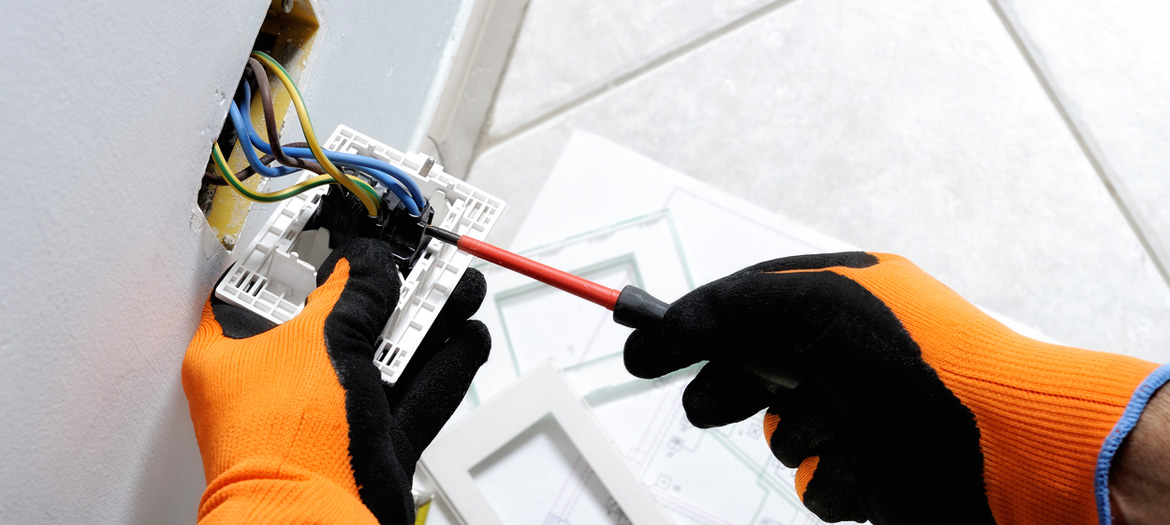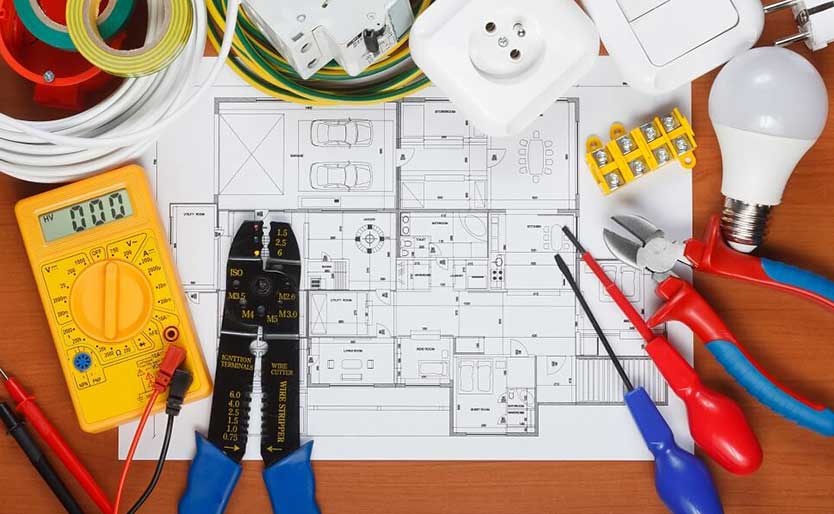Typical Electrical Troubles Every Home Owner Must Understand about
House owners usually run into different electric problems that can influence safety and functionality. Concerns like flickering lights and stumbled breaker are a lot more typical than lots of recognize. These scenarios can indicate much deeper electric issues that warrant focus. Recognizing the indications and threats associated with obsolete circuitry and dead outlets is necessary. What actions can be required to stop these issues? Exploring these typical electric problems can expose crucial understandings for maintaining a secure home environment.

Flickering Lights: Reasons and Solutions
Why do some property owners experience flickering lights? Flickering lights can be a common annoyance, frequently showing underlying electric problems. One main cause is faulty or loosened connections within light components or wiring, which can bring about periodic power supply. Additionally, using high-wattage home appliances on the very same circuit might create voltage variations, leading to flickering or lowering. An additional prospective problem is an overloaded circuit, where also several tools attract power simultaneously, stressing the electric system. Abject or out-of-date circuitry can contribute to irregular electrical flow. Sometimes, flickering lights may signal a problem with the home's electric panel or service line. Property owners should resolve flickering lights without delay to stay clear of possible hazards. Solutions may include tightening connections, rearranging device tons, or getting in touch with a certified electrician for a complete assessment. Recognizing the root reason can aid guarantee a secure and risk-free electrical system in the home.
Tripped Circuit Breakers: What You Required to Know
Have house owners ever wondered what creates their breaker to journey all of a sudden? This typical problem usually develops from an overload of electric circuits, where way too many devices draw power at the same time. In such cases, the breaker functions as a security device, interrupting the circulation of electricity to avoid getting too hot and possible hazards. An additional regular cause is a short circuit, which takes place when a live wire contacts a neutral cable, developing a rise of power that trips the breaker. Ground mistakes can likewise result in stumbled breakers; these happen when a live wire touches the ground or a grounded surface, posing major safety dangers. Homeowners should regularly examine their use of high-wattage devices to avoid straining circuits. In addition, comprehending the feature of breaker can assist them respond appropriately throughout a journey, guaranteeing their home remains well-kept and risk-free.
Out-of-date Wiring: Indicators and Dangers
Outdated wiring can pose substantial dangers to home owners, usually going unnoticed until troubles arise. Houses built prior to the 1980s may still have light weight aluminum circuitry or knob-and-tube systems, which are no more considered risk-free. Indications of obsolete circuitry consist of flickering lights, regularly stumbled breaker, or shedding scents near electrical outlets. These indicators may suggest that the electric system is loaded down or deteriorating.Additionally, homeowners might see scorch marks around electrical outlets or buttons, which can indicate overheating. The risk of electric fires markedly raises with obsolete electrical wiring, as these systems were not developed to deal with contemporary electrical lots. Property owners are encouraged to have their electrical wiring checked consistently, particularly when remodeling or adding new home appliances. By recognizing these indicators early, they can prevent dangerous scenarios and maintain a much safer living environment. Upgrading to current electrical criteria is a positive action in maintaining home safety and effectiveness.
Frequently Blown Fuses: Repairing Tips
Frequent blown fuses can show underlying electric problems that might originate from obsolete circuitry or overloaded circuits. Property owners experiencing this trouble ought to initially determine the home appliances attached to the affected circuit. It is a good idea to stay clear of using multiple high-wattage gadgets all at once, as this can result in circuit overload. If the trouble continues, inspecting the fuse box for indicators of wear or damages is vital; a defective circuit box might call for replacement.Additionally, examining for loose connections within the circuit can aid avoid future events. Property owners need to likewise validate that the integrates being used are of the right amperage, as making use of an incorrect fuse can aggravate the issue. Getting in touch with a qualified electrical contractor is suggested to review the electrical system better if these repairing tips do not settle the problem. Attending to these worries without delay can assist alleviate threats and assure the safety of the home's electric framework.
Dead Outlets: Common Causes and Fixes
When a home owner experiences a dead outlet, it can frequently give disappointment and confusion. A number of common reasons may bring about this concern. One frequent perpetrator is a tripped breaker, which can be conveniently reset. Homeowners should evaluate their electrical panel to examine if any kind of breakers are in the off position. One more opportunity is a malfunctioning electrical outlet itself, which might need replacement. Additionally, loose wiring links within the electrical outlet can interfere with power flow, making evaluation essential.Sometimes, the problem may originate from an overloaded circuit, especially when several gadgets are linked. In such instances, rearranging the electric tons can settle the concern. House owners need to also take into consideration the age of their electrical wiring; older systems may call for updates to meet modern-day electrical needs. If these actions do not rectify the circumstance, speaking with a licensed electrical expert is suggested to assure safety and security and proper medical diagnosis.
Electrical Shocks: When to Be Worried
Just how can home owners identify whether an electrical shock warrants problem? Homeowners ought to initially assess the severity and context of the shock. A moderate fixed shock, frequently felt when touching steel items, is normally safe and usual. However, if the shock takes place while engaging with a plugged-in device or electrical outlet, it might indicate an extra severe issue.The area and regularity of the shocks are vital. Repeated shocks from the same resource, particularly in wet locations like cooking areas or shower rooms, could signify faulty circuitry or poor grounding. Property owners ought to also take into consideration the experience of the shock; a shock that triggers click here now discomfort or muscle mass contractions is extra alarming than a plain tingle.If there's any type of unpredictability, it is advisable to seek advice from a certified electrician. Overlooking possible electric threats can cause serious security threats, consisting of fire or serious injury.
Overloaded Circuits: Avoidance and Precaution
Overloaded circuits pose significant threats in domestic settings, commonly leading to electrical fires or equipment damages (Level 2 Electrician). Home owners must identify the indications of an overloaded circuit, such as regularly tripped breakers or lowering lights. Implementing precautionary safety and security techniques can aid alleviate these dangers and assure a much safer see this page living environment
Identifying Overloaded Circuits
What signs suggest that a circuit may be overloaded? Home owners should be cautious for a number of crucial indicators. Frequently stumbled circuit breakers or blown merges suggest excessive lots on the circuit. Lowering or flickering lights, specifically when other devices are in use, can signify a poor power supply. Furthermore, outlets or switches that feel warm to the touch may indicate overheating, a possible fire threat. Unusual humming audios from outlets additionally call for interest, as they can symbolize electrical problems. Finally, if devices run inefficiently or stop working to begin, it might suggest an overloaded circuit. Identifying these indicators early can assist protect against serious electric problems and promote a more secure home setting.
Preventive Safety And Security Practices
To keep a efficient and secure electrical system, homeowners need to execute preventative safety and security practices that deal with potential circuit overloads. One reliable action is to stay clear of attaching way too many tools to a single outlet, as this can surpass the circuit's capability. Utilizing power strips with integrated circuit breakers can assist distribute power safely. House owners should additionally consistently examine cords and devices for damages and replace any kind of defective equipment quickly. It is important to guarantee that circuit breakers are functioning appropriately and to be knowledgeable about the overall power level being utilized in each circuit. In addition, seeking advice from a licensed electrician for periodic examinations can identify prospective issues prior to they rise, guaranteeing a safer living setting and extending the life-span of electrical systems.
Often Asked Concerns
Exactly how Commonly Should I Have My Electrical System Inspected?
Normal inspections of electrical systems are suggested every three to five years. Homeowners should take into consideration a lot more regular checks if they experience concerns, carry out renovations, or live in older buildings to assure security and compliance.
Can I Deal With Electrical Problems Myself or Hire an Expert?

What Are the Indicators of an Electrical Fire Risk?
Indicators of an electrical fire risk consist resource of regularly stumbled circuit breakers, flickering lights, shedding smells, discolored outlets, or warm, buzzing cables. Property owners ought to continue to be vigilant and seek professional help if any of these signs are present.
How Do I Know if My Home Demands an Electrical Upgrade?
To figure out if a home needs an electric upgrade, indications consist of constant breaker trips, outdated electrical wiring, not enough outlets, flickering lights, and the visibility of older electric panels, showing possible security risks and inefficiency.
Are There Specific Security Tips for Do It Yourself Electric Work?
When considering do it yourself electric job, one need to constantly switch off power, use shielded devices, confirm circuit performance, adhere to neighborhood codes, and speak with professionals for complicated tasks to guarantee safety and stop mishaps. One more possible concern is an overloaded circuit, where as well lots of devices attract power simultaneously, straining the electrical system. The risk of electric fires significantly raises with outdated circuitry, as these systems were not designed to manage modern-day electric loads. Regular blown fuses can show underlying electric problems that may stem from out-of-date electrical wiring or overloaded circuits. To keep a risk-free and reliable electric system, home owners should apply preventive safety and security techniques that deal with prospective circuit overloads. Level 2 Electrician Sydney. Indications of an electric fire risk consist of frequently stumbled circuit breakers, flickering lights, shedding odors, stained electrical outlets, or cozy, humming wires